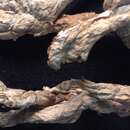Comprehensive Description
provided by Smithsonian Contributions to Zoology
Eunice polybranchia (Verrill, 1880)
Leodice polybranchia Verrill, 1880:358; 1881:323; 1885:428–429.
Eunice floridana.—Hartman, 1942:49–50, 52 [in part, not Eunice floridana Ehlers, 1887].
Eunice norvegica.—Pettibone, 1963:240–242, fig. 63f [in part, not Nereis norvegica Linnaeus, 1767].
MATERIAL EXAMINED.—Lectotype and 6 paralectotypes, YPM 2731, Fish Hawk sta 871, 40°02′54″N, 70°23′40″W, 210 m, fine sand with some mud, dredged.
COMMENTS ON MATERIAL EXAMINED.—The description is based on two incomplete specimens; variability of the species has been indicated in Table 13.
DESCRIPTION.—Long syntype incomplete with 85 setigers; length 52 mm; maximal width 3 mm; length through setiger 10, 8 mm. Short syntype incomplete with 42 setigers; length 23 mm; maximal width 3 mm; length through setiger 10, 8 mm.
Prostomium (Figure 91a) distinctly shorter than peristomium, about as wide as peristomium, as deep as of the peristomium. Prostomial lobes thick, frontally rounded, dorsally inflated; median sulcus shallow. Eyes between bases of A-I and A-II, dark. Antennae in a horseshoe, with A-I isolated by a gap, similar in thickness. Ceratophores ring-shaped in all antennae, without articulations. Ceratostyles tapering, without articulations, sometimes with contraction rings. A-I to posterior peristomial ring or to setiger 1; A-II to setigers 4–6; A-III to setigers 6–11; A-III broken. Peristomium cylindrical, with distinctly inflated lower lip. Separation between rings distinct dorsally and ventrally; anterior ring of total peristomial length. Peristomial cirri to posterior part of prostomium, tapering, without articulations.
Maxillary formula 1+1,6+5,8+0, 5+9, and 1+1. Mx III long, located behind left Mx II. Mx VI absent.
Branchiae (Figure 91e) present, pectinate, distinctly longer than notopodial cirri, not reduced in mid-body region, erect. Branchiae from setigers 7–8 to last of segments present (85 setigers). First branchia short, tapering filaments; maximum 5 filaments reached at about setiger 15 and maintained over next 10–15 setigers. Filaments thick, stiff, bent posteriorly, so branchiae project over next posterior intersegmental furrow.
All neuropodial acicular lobes conical; anterior acicular lobes asymmetrical, becoming more and more symmetrical in median setigers (Figure 91h); aciculae emerging at tip of acicular lobes. Pre- and postsetal lobes low, transverse folds. First 4 ventral cirri thick and tapering. From about setiger 5 ventral cirri basally inflated; from about setiger 15 through setiger 50 ventral cirri thick ventrolateral ridges; narrow tips short and button-shaped. Inflated bases reduced from about setiger 50; ventral cirri gradually displaced to posterior face of neuropodia, directed dorsally behind acicular lobes. In last setigers present ventral cirri thick, tapering. Notopodial cirri digitiform, without articulations. Posterior notopodial cirri curved over next posterior intersegmental furrows.
Limbate setae slender, marginally smooth. Pectinate setae (Figure 91d,f) flaring, furled. One marginal tooth distinctly larger than other teeth; 15 teeth present. Shafts of compound falcigers (Figure 91g) inflated, marginally serrated. Appendages (Figure 91b,g) tapering; heads distinct, bidentate. Proximal and distal teeth similar in size in anterior and median setigers; proximal teeth longer than distal teeth in posterior setigers. Proximal teeth triangular, directed laterally. Distal teeth gently curved. Guards symmetrically bluntly pointed; mucros absent. Pseudocompound falcigers and compound spinigers absent. Notopodial aciculae slender, brown. Aciculae paired, with dark brown to black cores and clear sheaths, tapering, gently curved, considerably more prominent in posterior than in anterior setigers; cross-section round. Subacicular hooks (Figure 91c) with dark brown to black cores and clear sheaths, bidentate. Hooks first present from setiger 24–36 (29 and 30 in 2 syntypes described), present in all setigers thereafter, always single (except for replacements). Proximal tooth twice as large as distal teeth, directed laterally. Distal teeth nearly erect.
UNKNOWN MORPHOLOGICAL FEATURES.—Pygidium and anal cirri.
EXPECTED STATES OF UNKNOWN MORPHOLOGICAL FEATURES.—None.
CHARACTERS USED IN PREPARATION OF KEY NOT SCORED.—Inappropriate Characters: 22, 56, 58, 59. Unknown Characters: 1, 2,4, 6, 36–38,40,47, 50, 63.
ASSUMED STATES FOR PURPOSE OF PREPARING KEY.—37,1; 38,1.
- bibliographic citation
- Fauchald, Kristian. 1992. "A Review of the Genus Eunice (Polychaeta: Eunicidae) Based upon Type Material." Smithsonian Contributions to Zoology. 1-422. https://doi.org/10.5479/si.00810282.523

